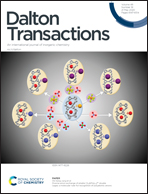A 195Pt NMR study on zero-magnetic-field splitting and the phosphorescence properties in the excited triplet states of cyclometalated platinum(ii) complexes†
Abstract
We report the factors governing zero-magnetic-field splitting (zfs) in the lowest-energy electronically excited triplet (T1) states of cyclometalated platinum(II) complexes, whose zfs energies between the lowest- (φ1) and highest-energy spin-sublevels (φ3) in the T1 states (ΔEzfs) are already known: [Pt(bhq)(dpm)] (1Pt), [Pt(thpy)(acac)] (2Pt), [Pt(ppy)(acac)] (3Pt), cis-[Pt(thpy)2 (4Pt), and cis-[Pt(ppy)2] (5Pt), where bhq, dpm, thpy, acac, and ppy are benzo[h]quinoline, dipivaloylmethane, 2-(2-thienyl)pyridine, acetylacetone, and 2-phenylpyridine, respectively. As one of the important findings, we show the relationship between the ΔEzfs and 195Pt NMR chemical shifts of the five Pt(II) complexes. The implications of the ΔEzfs values on the emission properties of the Pt(II) complexes in acetonitrile at 293 K are also discussed. In particular, we demonstrate that the radiative rate constants of the Pt(II) complexes correlate with both ΔEzfs and 195Pt NMR chemical shifts.



 Please wait while we load your content...
Please wait while we load your content...